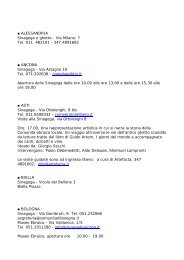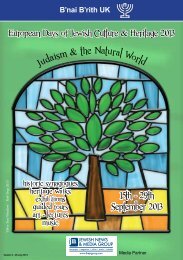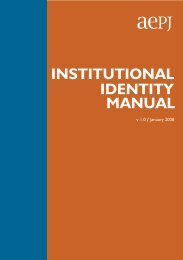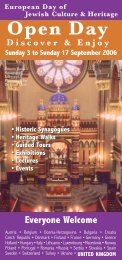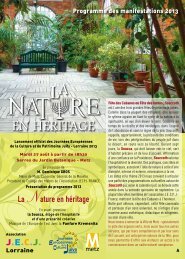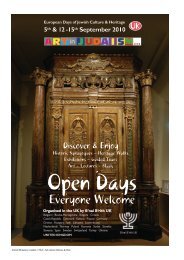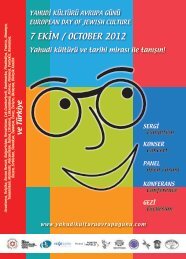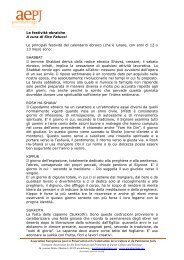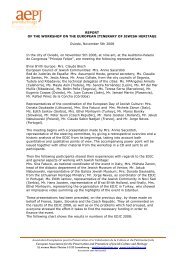programa jornada europea 2005 - Red de JuderÃas de España
programa jornada europea 2005 - Red de JuderÃas de España
programa jornada europea 2005 - Red de JuderÃas de España
Create successful ePaper yourself
Turn your PDF publications into a flip-book with our unique Google optimized e-Paper software.
CONTENT PAGE/TABLE DES MATIÈRES<br />
INTRODUCTION<br />
1. Introduction<br />
2. Programmes <strong>2005</strong><br />
3. Annexes<br />
3.1. List of national coordinator<br />
3.2. Comparative data 1999-<strong>2005</strong><br />
• General information<br />
• Participants<br />
• Countries<br />
• Cities<br />
• Activities<br />
3.3 Data of the <strong>2005</strong> European Day of<br />
Jewish Culture<br />
1. Présentation<br />
2. Programmes <strong>2005</strong><br />
3. Annexes<br />
3.1. Liste <strong>de</strong>s coordinateurs<br />
nationaux <strong>2005</strong><br />
3.2. Comparaison chiffrée 1999-<strong>2005</strong><br />
• Information génerale<br />
• Participants<br />
• Pays<br />
• Villes<br />
• Activités<br />
3.3.Chiffres <strong>de</strong> la Journée Européenne<br />
<strong>de</strong> la Culture Juïve <strong>2005</strong><br />
Jewish Heritage is an integral part of European<br />
history and culture. Most of Jewish history and<br />
culture is rooted in Europe, with a story ma<strong>de</strong> of<br />
migrations, persecutions and precariousness, but<br />
also of exchanges, humanism and a profusion of<br />
mutual enrichment. Judaism has had an impact on<br />
the lifestyles (cooking, singing, dancing, language<br />
etc.) of most Europeans be it by the values, which it<br />
promotes, or by the fact that throughout centuries<br />
Jews and non-Jews have lived together. In<strong>de</strong>ed,<br />
everywhere they have lived and everywhere where<br />
they were able to, Jews built synagogues, have left a<br />
cemetery and of other traces, not only to express<br />
their faith, but also to let the living testimony of<br />
their presence as well as of their contribution to life<br />
and the <strong>de</strong>velopment of their village, city or region.<br />
Pledge of particularism, this heritage is also a sign of<br />
their will to integrate in the surrounding society,<br />
without giving up their religion, but enriching their<br />
contribution the evolution of a common life.<br />
The European Route of Jewish Heritage<br />
consists in the highlighting of the buildings which<br />
have been left to us by the Jewish communities<br />
across Europe. It crosses Europe from the South to<br />
the North and from Western Europe to Central and<br />
Eastern Europe. Jewish sites are linked by common<br />
elements by a Jewish heritage which is a full part of<br />
the historical and cultural European Heritage.<br />
Jewish institutions,<br />
- A growing number of museums to study, protect<br />
and publicise Jewish life and its religious and daily<br />
artefacts,<br />
- A large <strong>de</strong> number of programmes: cultural,<br />
aca<strong>de</strong>mic, professional and youth exchange<br />
between people from different religions,<br />
cultures and countries.<br />
In doing so, it inevitably tackles the wi<strong>de</strong>r issue of<br />
Judaism, Jewish culture and Jewish traditions in<br />
today's Europe.<br />
The European Route of Jewish Heritage makes the<br />
Jewish sites more visible whilst at the same time,<br />
making the cults in Judaism more apparent,<br />
transparent and accessible to European citizens.<br />
This project participates in the education process<br />
on tolerance of the citizens.<br />
The main goals of the European Route of<br />
Jewish Heritage are to preserve and promote<br />
Jewish heritage as European heritage, to promote<br />
tourism around these sites and to make the<br />
Europeans aware of the cultural richness brought by<br />
the Jews across Europe during their stay in so many<br />
different regions.The Route of Jewish Heritage will<br />
not only enable visitors to discover the history of<br />
the Jewish people but will also enable them to<br />
know better their local and national history.<br />
In this context, in 2001 the European Institute of<br />
Cultural Routes proposed to <strong>de</strong>velop the "Day"<br />
into the European Route of Jewish Heritage, as an<br />
additional itinerary connected to the programme<br />
"Europe:A common Heritage "<br />
The project was born out of the European Day of<br />
Jewish Culture. Launched in 1996 in the Bas-Rhin<br />
(Alsace/France), un<strong>de</strong>r the Open Day formula by<br />
the Jewish association B'nai B'rith Hirschler in<br />
Strasbourg, in partnership with the Agence <strong>de</strong><br />
The European Jewish Heritage mainly inclu<strong>de</strong>s:<br />
Développement Touristique du Bas-Rhin, each<br />
- Archaeological sites, old synagogues and<br />
cemeteries, ritual baths, Jewish quarters,<br />
monuments and memorials,<br />
- Archives and libraries held by Jewish and non-<br />
summer many Jewish sites were opened to the<br />
public. Activities were organised around these sites<br />
such as tours, lectures, concerts etc.The event was<br />
broa<strong>de</strong>ned three years later and became a truly<br />
2 1



